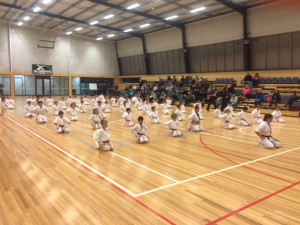Colored belts have their origin in Judo, as does the training ‘gi’, or more correctly in Japanese, ‘dōgi’.
In Kyokushin Karate, each colored belt from Red Belt to Brown Belt inclusive has two levels, the second being represented by a black stripe on the tip of the belt.
There are many ideas of how the belt colours came to be, but from time long gone by, in the beginning students of a karate school would be given a White Belt. The students’ belts would gradually become stained darker from use and eventually a person who was of a high standard and who had trained for a long time would then have a brown/ black (earth coloured belt). This was an inspiring way to encourage students to train harder. Now days, the coloured belt at each level after long and endured training, including Black Belt, will commence to fade and return to purity (White Belt). Karate-ka (students) never wash their belt as it is said to contain all the time, hard toil and spirit required to attain the next level. The only time the belt is immersed in water will be the likes of beach or waterfall training.
Perhaps the most widely read interpretation and respected of the fundamental psychological requirements of each level is found in the book, “The Budo Karate of Mas Oyama”, written by former interpreter to Sosai Mas Oyama, and long term friend, Shihan Cameron Quinn. It is mentioned that, Kyokushin karate has a belt grading system similar to other martial arts. The requirements of each level vary from country to country, some far more strict and more demanding than others. For example, in Australia, the grading for each level requires the student to complete the entire requirements for each level from most junior up to the rank being tested. So the student attempting Shodan (first degree black belt) as an example, will do all the White Belt requirements, then all the Red Belt requirements, the Blue Belt requirements and so on. The sparring (kumite) requirements for Shodan usually ranges from twenty to forty rounds, depending on the region. It is quite common that contact made during sparring for Shodan is very “testing” but this is well supervised depending on the candidate’s gender, age, size, ability etc. Regardless of those guidelines, the candidates are by this time well prepared and are well conditioned to be successful. Occassionally, a student who for what ever reason, hasn’t or couldn’t complete their grading test on any nominated date. So, instead they may be given permission to be tested and graded in normal training environment (dojo class), but they are still required to complete the grading format, including kumite (sparring). In actual fact, this is the more difficult test as being in the minority, the “spot light” is directly on the candidate.
The belt assigned to each student upon commencing training is a white belt. With each successful grading attempt the student is awarded a kyu ranking, and either a stripe on his current belt or a new belt colour altogether. Grading, or promotion tests, may include Kihon (basics), Ido geiko (moving basics), Goshinjitsu (self defence), Sanbon and Ippon kumite (three and one step sparring), Kata (prescribed series of movements/forms), Kumite (sparring), all of which are aerobic training at a level for each rank. For Black Belt, Tameshiwari (Eg board breaking techniques). Achieving a 1st dan Black Belt(Shodan), usually takes an average of around 6 years, but some students choose to take longer to be well prepared. A belt may be awarded only by a teacher after a grading, you will have to wait until a “grading” usually only performed 2 or 3 times a year (depending on the student) or at camps where you can see the shodan and above gradings, and rarely 50 man kumite also are performed. At the highest ranks (6th dan and above) tests are performed by international committee, or, as is more common in the post-Mas Oyama era, presented honorarily.
Each belt has a different number of sparring rounds required and the level of intensity once again depends on the student. We wish to provide training for everyone. Of all aspects though, it is the strong and spirited kumite that most defines the Kyokushin style and it is this aspect that has always brought the style the most respect. The one thing that usually defined the Kyokushin Black Belt was the spirit, strength and courage.
Shodan in Kyokushin Karate is the supreme test of fortitude as well as skill.
However, it is actually too the new beginning (Sho-Dan actually means “first level”) training continues and one must only push forward to continually improve and progress……Ni-dan, San-dan, (Second Dan, Third Dan) etc….
YOUNG LIONS SPECIALIST TRAINING FOR CHILDREN – GRADINGS;
A specific grading system for Young Lions candidates has been devised to match their training and requirements in order to assist in having them progress slowly but surely with the intent of then integrating them into the main stream / general classes.
This system has now proven to be extremely successful in keeping children  involved in training until they gain knowledge, strength and confidence. We now have numbers of Young Lions both girls and boys who have entered into mainstream Kyokushin Karate training and life.
involved in training until they gain knowledge, strength and confidence. We now have numbers of Young Lions both girls and boys who have entered into mainstream Kyokushin Karate training and life.

